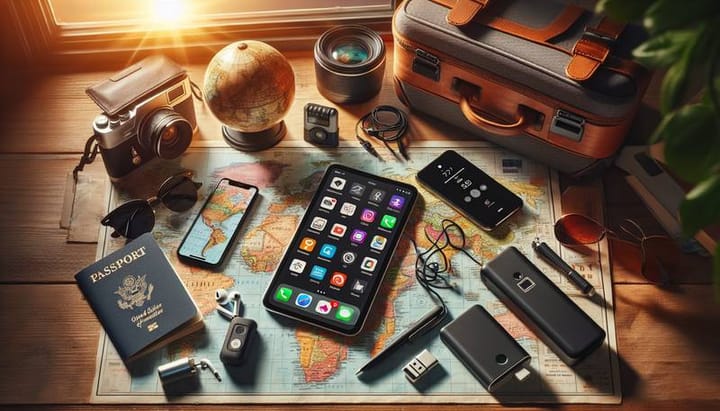The Basics of Mobile App Security

Welcome to our comprehensive guide on the basics of mobile app security! With the exponential growth of mobile app usage, security has become a major concern for users globally. Whether it's banking, shopping, or just socializing, we're doing more on our phones than ever before. But with great convenience comes great risk. In this guide, we're going to explore the ins and outs of keeping your mobile applications secure. From understanding permissions to safeguarding your personal data, we've got you covered. So, let's begin our journey into the world of mobile app security and ensure that your digital life is both easy and safe.
The Importance of Mobile App Security
Why should you care about mobile app security? The answer is simple: your personal and financial well-being could be at stake. As we increasingly rely on mobile apps for daily tasks, sensitive information like credit card numbers, health records, and personal identification details are stored on our devices. Cybercriminals are continually devising new methods of attack to access this data. The implications of a security breach can be catastrophic, ranging from identity theft to financial loss, and even legal repercussions. This is precisely why mobile app security should never be an afterthought. It’s a critical aspect that deserves your attention every time you download and install an app. It's important to understand that app security is a shared responsibility. While app developers must implement robust security measures, as an end-user, you must be vigilant and knowledgeable about how to protect your own data. By being aware and taking the necessary precautions, you can significantly reduce the chances of falling victim to cyber threats.
Understanding App Permissions
App permissions can often seem like just another pop-up to click through when installing an app, but they deserve closer attention. Essentially, permissions grant apps access to different systems on your device. For instance, a photography app may request access to your camera and photos, while a call-blocking app might ask for access to your contact list and call logs.However, it's vital to pause and consider why an app is asking for certain permissions. Does a simple note-taking app really need access to your location? If an app's permissions seem extensive or unrelated to its functions, it could be a red flag. Always review permissions carefully before proceeding and utilize the "deny" button when an ask doesn't seem to add up. Remember that you can usually adjust permissions after installation in your device settings.By keeping a close eye on app permissions, you can minimize the risk of personal information being misused. It's a small effort that can make a big difference in protecting your data and ensuring that apps only access what they genuinely need to function as intended.
Securing Your Data
Data security in mobile apps is a multi-layered topic. Firstly, a strong password is your first line of defense. It's important to create unique, complex passwords for all your accounts. Avoid easy-to-guess combinations like "123456" or "password" - they’re invitations to hackers. Consider utilizing a reputable password manager to help keep track of your different credentials while ensuring they remain strong and secure.Next, enable two-factor authentication (2FA) wherever possible. This adds an extra security layer by requiring a second form of verification, such as a text message with a code or a fingerprint, before accessing your account. Even if a hacker manages to crack your password, 2FA can stop them from going any further.Encryption is another critical term in the world of app security. It scrambles your data, making it unreadable to anyone without the correct decryption key (usually your password). Look for apps that offer end-to-end encryption for data transmission and storage. Furthermore, be cautious about using public Wi-Fi for transactions or sensitive operations. Hackers often lurk on these networks, looking to intercept unencrypted data. Using a virtual private network (VPN) can provide an extra security layer by encrypting all data leaving your device, even on public networks.By integrating these practices into your digital routine, you'll significantly enhance the security of your personal information and reduce the chances of it falling into the wrong hands.
Staying Up-to-Date with App Updates
Keeping your apps up-to-date might seem like a chore, but it's a crucial aspect of your digital security regimen. App developers regularly release updates to fix bugs, address security vulnerabilities, and improve overall functionality. Failing to update could leave your app - and by extension, your device - susceptible to security breaches.Automating updates is a simple solution. Most devices offer an option to update apps automatically, making it a hassle-free process. If you choose to update manually, make a habit of checking for updates regularly. Don't ignore those update notifications; they could be the difference between a secure or compromised app.It's also worth noting that updating your operating system is just as important. Like app updates, these often contain critical security patches. Keeping everything current is one of the easiest ways to bolster your defenses against potential threats.
Protecting Against Malware
Malware, an umbrella term for malicious software like viruses, spyware, and ransomware, poses a serious threat to mobile app security. It can infiltrate your device through app downloads, especially from unofficial sources, email attachments, or even malicious advertisements. Once inside, malware can wreak havoc – from stealing personal information to locking you out of your data until a ransom is paid.To guard against malware, it’s crucial to download apps only from official app stores, like Google Play for Android or the App Store for iOS. These platforms have security measures in place to detect and eliminate most malware-infested apps. Enable scanning for threats in your device settings and consider installing a trusted mobile security app for an added layer of protection. Be wary of unsolicited communications that prompt you to download an app or click on a link, even if they appear to be from familiar sources. Phishing attempts can be quite sophisticated, mimicking legitimate companies to trick you into installing malware on your device. If an offer seems too good to be true or a message seems out of character for the sender, trust your instincts and investigate further before taking action.Regular backups are another key defense against malware. If your device is compromised, a recent backup can be a lifeline, allowing you to restore your apps and data to a pre-attack state. With these measures in place, you can significantly reduce the risk of malware infections and their potential damage.
By understanding and implementing these basic mobile app security measures, you are taking a giant leap towards protecting your digital life. Stay informed, stay cautious, and always prioritize your digital security in this ever-evolving tech landscape.
Be Cautious with Public Wi-Fi
Public Wi-Fi networks offer convenience, but they often lack strong security measures, which makes them hotspots for cyber criminals looking to intercept data. When you connect to a public Wi-Fi, you are potentially sharing a network with malicious actors who can use tools to eavesdrop on your internet traffic and capture sensitive information such as login credentials and credit card numbers.
To protect yourself, avoid performing sensitive activities like online shopping or banking on public Wi-Fi. Similarly, if you must use public Wi-Fi, ensure to do so via a reputable Virtual Private Network (VPN). A VPN encrypts your internet connection, which means even if someone intercepts your data, they would not be able to decipher it. Furthermore, always verify the Wi-Fi network is legitimate—sometimes, attackers set up fake hotspots to trick users into connecting.
Understand the Role of Mobile Application Management (MAM)
Mobile Application Management (MAM) refers to the strategy employed by organizations to secure and manage the apps used on company devices or personal devices that are used for work purposes. With BYOD (Bring Your Own Device) policies becoming more common, the lines between personal and professional app usage can blur, making MAM an important aspect of enterprise security.
MAM tools allow IT departments to control app distribution, updates, and removal from a central location. They also enable the enforcement of security policies, such as requiring data encryption or blocking the copy and paste function to prevent data leakage. For individual users, understanding MAM can activate your awareness when using work-related apps on personal devices and encourage you to adopt secure app habits, such as not storing sensitive work data on non-secured apps.
The Role of Platform Security
Every mobile platform comes with its built-in security features that play a significant role in protecting your apps and data. For example, both Android and iOS require apps to run in isolated environments—a practice known as sandboxing. This limits the apps' access to system resources and your data, thereby preventing any malicious app from affecting the entire system.
Stay informed about the security features specific to your platform and how you can leverage them. This may be utilizing biometric features like fingerprint scanning or facial recognition for secure access, enabling "Find My Device" feature to track and potentially wipe your device if it gets lost or stolen, or understanding the platform’s privacy settings to control the data accessible to apps. The more you know about platform security, the better equipped you are to take advantage of these features.
Avoid 'Rooting' or 'Jailbreaking'
'Rooting' your Android device or 'Jailbreaking' your iPhone means disabling official OS restrictions to gain more control over your device. While this may sound appealing to customize your phone or use certain apps, it significantly weakens your device's security. You essentially remove designed protections, making your device more susceptible to malware and attacks.
Furthermore, rooting or jailbreaking can void your warranty and make it more challenging to receive timely OS updates, which as we’ve already established, are crucial for security. Sticking to your device’s official OS guidelines may limit customization but goes a long way toward ensuring your overall app security.
Conclusion: Secure Your Mobile Experience
In conclusion, mobile app security is not just a concern for IT professionals but for all smartphone users. By following the guidelines provided in this article — paying attention to app permissions, securing your data with strong passwords and encryption, staying up-to-date with the latest updates, protecting against malware, exercising caution on public Wi-Fi, understanding MAM and platform security, and avoiding risky behaviors like rooting or jailbreaking — you can fortify your mobile security against the majority of threats.
Beyond just technical measures, being aware and proactive about your digital habits is a vital part of staying secure in the mobile world. Educate yourself about the latest security threats, practice good digital hygiene, and remember, when it comes to your personal information, you can never be too careful. With diligence and the right practices, you can enjoy the ubiquitous convenience of mobile apps without compromising on security.
Armed with this knowledge, you are well on your way to ensuring a safer mobile app experience. Always stay vigilant, stay informed, and enjoy the peace of mind that comes with taking your mobile app security seriously.


